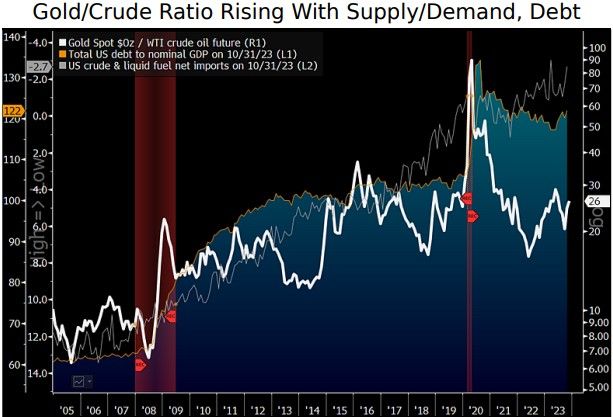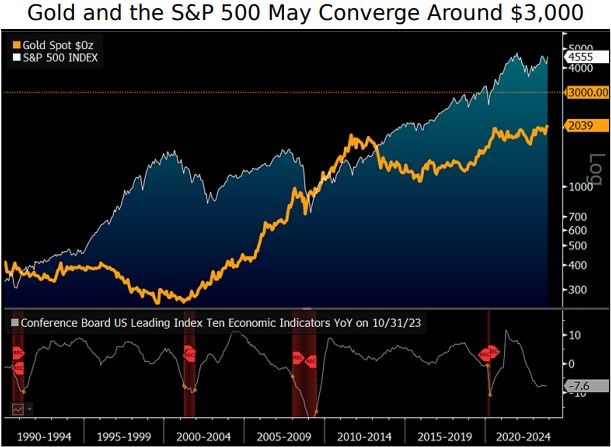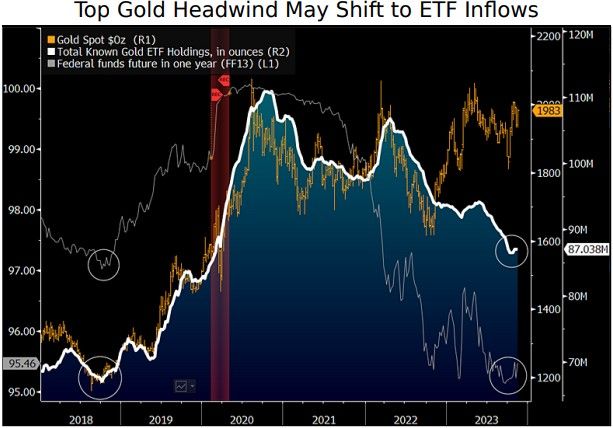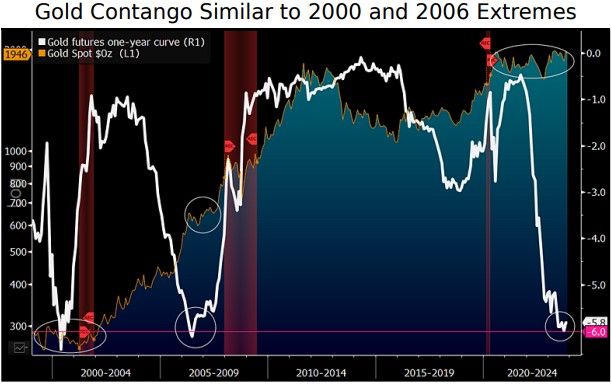(Kitco News) – As macroeconomic conditions continue to deteriorate, the gold prices is poised to hit new highs in 2024, and even has the potential to hit $3,000, according to Bloomberg Intelligence Senior Commodity Strategist Mike McGlone.
“Gold outperforming most commodities and the S&P 500 on a year-over-year basis to Nov. 29 may show inklings toward our base case: A great reset worthy of the biggest liquidity-pump-then-dump in history,” McGlone said in his “Global Commodities 2024 Outlook.”
“The lessons of four decade highs in inflation could be enduring and curtail Federal Reserve easing,” he said. “Gold is on track to shift $2,000 an ounce resistance into support, copper may head toward $3 a pound and WTI crude oil approach $40 a barrel, if Bloomberg Economics’ US recession outlook plays out.”
McGlone noted that the appearance of gold at the top of BI’s annual macro performance scorecard while the Bloomberg Commodity Spot Index is on the bottom indicates that the markets are on a path toward global recession.
“The potential for trend reversal or acceleration is a key question for 2024, and our bias is the latter,” he said. “What appears unsustainable are falling Treasury bond and rising stock-market prices, especially with 2024 US recession outlooks from Bloomberg Economics and the Conference Board’s index of leading indicators.”
He warned that the impact of the coordinated rate hikes by central banks in 2023 may not be fully felt until 3Q24, and said “The US stock market likely needs to remain resilient or deflation may be a primary theme a year from now.”
“Another global recessionary signal is that energy is at the bottom of our commodity-sector annual performance scorecard and precious metals are on top,” McGlone said. “A primary spark that may accelerate this trend is a typical US stock-market drawdown for a recession. If that can be avoided and Europe and China rebound from sliding growth – on the back of the most aggressive global central-bank tightening period ever, which may not have ended in 3Q – commodity prices could stabilize in 2024.”
He said their “Base case for a great reset is guided by the lessons of history, economics, and big liquidity pumps that dump. The year 2025 may be marked by a lower plateau in risk assets and underpinnings from central bank easing. The down leg of a typical commodity cycle and the Fed still focused on higher for longer might tilt 2024 outperformance toward gold.”
Another trend that could accelerate in 2024 is lower energy prices vs. rising gold prices.
“The typical cycle for crude oil and natural gas, on the back of getting too expensive in 2022, is to get too cheap and help reset supply and demand,” McGlone said. “Our bias, that elasticity forces are stronger than ever and Russia’s invasion of Ukraine was an additional catalyst, is playing out, as indicated by most commodity prices falling in 2023 and gold rising. That WTI crude bottoms have been about $40 a barrel since 2008 could signal potential that rising gold is anticipating.”
“It’s a question of what stops the propensity for energy prices to get too cold, particularly with the Conference Board’s leading indicator index at minus 7.6%, and we see diminishing options,” he added. “Price buoyancy after a period of central bank easing may be what markets can look forward to in 2025.”
McGlone said the “shift in the link between gold and crude oil in favor of the metal” that started during the Great Recession “may accelerate in 2024.”
“Two key factors that have buoyed the ratio of WTI crude barrels per ounce of gold to 26x on Nov. 17 from around 7x in 2008 are rapidly rising debt-to-GDP and the US shift to a net crude and liquid fuel exporter,” he said. “These trends appear enduring and may gain momentum if the US enters a recession in 2024, as forecast by the Conference Board’s leading indicators.”
“The widening excess of US and Canadian liquid fuel production vs. consumption, and declining demand for gasoline, natural gas, diesel and containerboard, may overwhelm OPEC’s attempts to shore up crude prices,” he said. “Our graphic shows rising gold-to-crude since 2008 and the tendency for the ratio to spike in recessions.”
“Advancing gold and declining oil may be showing leanings for 2024,” he said. “The per-ounce price of the metal at less than half the S&P 500 index is historically low, notably if the economy contracts.”
To make the case for a $3,000 gold price in 2024, McGlone pointed to the performance of gold versus the S&P 500 over the past three and a half decades.
“Our chart of gold and the S&P 500 on the same scale shows convergence potential around $3,000,” he said. “The Conference Board’s index of leading indicators at minus 7.6% may be the catalyst. Recessions have been consistent with similarly depressed LEI’s since 1960. A top headwind for gold in 2024 may be if interest rates and equity prices remain elevated. Aggressive central bank buying of the metal could continue until higher prices curtail demand and incentivize supply.”
“Most central banks were tightening in 3Q, which may indicate the full effects won’t be felt until 3Q24, with bullish gold implications,” McGlone added. “Debt typically rises vs. GDP and precious metals outperform industrials in US recessions. Advancing gold vs. most commodities in 2023 could be a sign of what’s to come when the effects of aggressive 2022-23 rate hikes take effect.”
Another sign that gold is gearing up for another positive year in 2024 is the fact that outflows from gold ETFs in Q4 have diminished compared to previous years.
“Gold ETFs typically see outflows in 4Q, but 2023 may be bucking the trend, with implications for prices,” he said. “Largely offset by central bank buying, our graphic shows a major price headwind for the metal – ETF selling – could be reversing. The about 7% one-year drop in gold ETF holdings vs. the 10% gain in the metal’s price to Nov. 16 is the most extreme crocodile-jaw pattern since the SPDR Gold Shares (GLD) was launched in 2004.”
“Total known gold ETF holdings have bounced 1% since Oct. 19. The past 10 years, gold ETF holdings in ounces have dropped 3.1% on average in 4Q,” he said. “A Federal Reserve pivot akin to the last one in 4Q18, when the metal bottomed around $1,200 an ounce, may be what gold investors are anticipating, but we see little reason for easing until the stock market falls, which is normal in recessions.”
The steep gold contango seen at the end of 2023 also portends a major rally for the yellow metal, McGlone said. “The previous two times that the one-year gold futures curve was in similar steep contango as now, US recessions and sharp rallies in the metal followed with implications for 2024.”
“Our chart shows the one-year-back gold futures price about 6% above the front and for good reason – high US interest rates,” he said. “Due to its quasi-currency and store-of-value attributes, the gold curve is the most straightforward among commodities and the swift shift to extreme contango may have repercussions akin to 2000 and 2006. In 2001, gold started a 12-year run of gains and the 31% rise in 2007 was the greatest since 1979.”
“Steep contango in gold futures is consistent with Bloomberg Economics and the Conference Board’s leading indicators for a US recession starting soon, which may pressure risk assets and buoy the metal,” McGlone said.
And if Bloomberg Economics is right about the US entering a recession around year-end, “GLD may be a top potential commodity ETF performer vs. SPY,” he added. “GLD was the first major commodity ETF and is the biggest at about $55 billion, and it’s been among the few material ETFs holding its own vs. SPY.”
He noted that “the GLD-to-SPY ratio [is] at about the same level as when the spot gold ETF was launched in 2004 and since 2017,” and said its lack of change when compared to the SPY for the past six years “makes it an outlier among commodities, especially compared with most futures-based ETFs.”
“At about a 50% discount to the S&P 500, the per-ounce price of gold is ripe to revert higher, if US unemployment continues to rise,” he said. “Since the US ditched the gold standard in 1971, when the metal was below the stock index and unemployment rose, gold typically outperformed. If equity prices have a normal recession drawdown, it might be a catalyst for gold to rally.”
Disclaimer: The views expressed in this article are those of the author and may not reflect those of Kitco Metals Inc. The author has made every effort to ensure accuracy of information provided; however, neither Kitco Metals Inc. nor the author can guarantee such accuracy. This article is strictly for informational purposes only. It is not a solicitation to make any exchange in commodities, securities or other financial instruments. Kitco Metals Inc. and the author of this article do not accept culpability for losses and/ or damages arising from the use of this publication.
Credit: Source link




